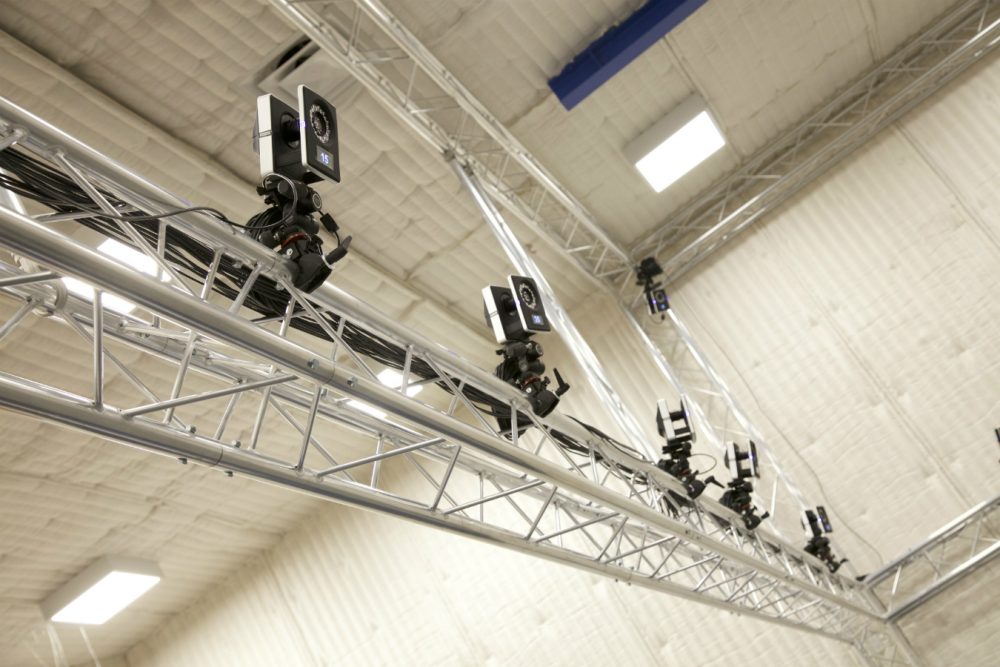In the basement of the Vancouver Film School (VFS)’s Film Production campus, there used to be a giant pirate ship. But now all that remains of the set is one large wooden pole, jutting from the ceiling right to the floor.
Christopher Bennett, head of marketing at VFS, stares up at it in wonder. “They’re going to fill this mast with signatures of all the actors and other people for all the projects that come in here,” he says. “In a year and a half, imagine, this thing is going to be full. It’s going to be amazing to watch.” Because this space that once held a pirate ship is now a state-of-the-art performance capture studio—one of only two of its kind in all of Canada, and rivalling the best iterations around the world.
Performance capture means every move, facial expression, and breath of an actor is recorded; unlike motion capture, which essentially just logs basic movements, performance capture is a full-body experience, allowing that actor’s scene to, with the help of special effects, take place anywhere. Though the VFS studio doesn’t look like much to the untrained eye—soundproofed walls, cameras perched along the perimeter—it is actually quite a high-tech and intricate space.
“I’ve been trying to tell my dad what I do for 10 years and he still can’t figure it out,” jokes Graham Qually, president of Mimic Performance Capture, who came to VFS in the first place to suggest partnering together on the studio. “Essentially the cameras record everything, and then we can do whatever we want with that. We can literally have people floating, we can have them under the water, we can do anything we want, put them in any scene.” Qually, whose background is in video game production at companies including Ubisoft, founded Mimic in 2017 in Vancouver. From there it became about finding a studio space that could house world-class performance capture equipment—because Qually is certain that is where the gaming, film, and television industries are headed. By partnering with a post-secondary school, he not only has some of the financial burden taken off his shoulders, but he also gets to give students firsthand experience at a pristine facility.
“It’s never been done before where they take a commercial studio and put it inside a school and give students access to it,” Qually says. “[VFS] students can use this absolutely free of charge. So it’s at their fingertips, 40 days a year. Which is huge.” The rest of the time, Mimic will be working on commercial shoots, be they video games or blockbuster films. And each project will employ VFS alumni who have trained at this campus and will come out with the skills they need to begin work immediately. “They’re not interns. They get industry rates,” Qually says proudly. “It’s breaking that idea of, ‘You need experience to get experience.’ I learned from working at Ubisoft before, that generally what a person’s salary is, you double it for training. So if someone is making $50,000, it actually costs the company another 50 to get them up to speed. That’s why a lot of companies have a lot of trouble taking risks on people. I don’t have to worry about that. I see all of these students come through the program with us, so I know when they come out of the school they’re ready to come on a commercial shoot floor. So then I shoot with them, and then they can go anywhere and say, ‘Yeah, I shot the last Gears of War’; ‘I shot the new Resident Evil’; ‘I did it here at VFS as an alumnus, two weeks after I graduated.’”
An elaborate and advanced studio build such as this should have taken six months, but VFS and Mimic did it in just two. Qually himself and even VFS vice-president of education Ted Gervan were on the pirate ship demolition team, wielding hammers and lugging out wood. “We literally came down here and did it ourselves—5,500 pounds we moved out of this room,” Qually says. “We couldn’t do it from 9 a.m. to 9 p.m. because it’s paramount that students don’t get disturbed—VFS is very protective of their students, you can’t be making a ton of noise—so we were working from 4 a.m. to 9 a.m., or 9 p.m. to two in the morning. Whatever it took. It was a lot of fun.” Upwards of $1.5 million later, the studio is equipped with 40 Vicon Vantage cameras (costing $25,000 each); four head-mounted cameras ($30,000 each); custom-designed stunt mats; three 40-foot stunt beams that can each hold up to 3,500 pounds; and 36,000 cubic-feet of actual shoot floor. Qually knows that in order to be viable he has to stay ahead of the curve technology-wise, so Mimic, and therefore VFS students, will always be working with the very best equipment available.
For those unsure how to spot performance capture, look no further than James Cameron’s 2009 smash hit Avatar. Those body movements and facial expressions really belong to the actors—what performance capture technology did was take it all, convert it, and add the bells and whistles (in Avatar’s case, that meant the blue skin on the actors and the entire alien world known as Pandora that surrounded them). And while performance capture is a rapidly growing industry sector, not many studios of VFS’s magnitude exist; because of that, Qually is confident that Hollywood will come knocking, and Bennett is certain that the Academy will, too. “I like to tell people there’s going to be an Oscar won for performance capture in the next couple years,” Bennett says. “And I’m willing to bet big money that it’s going to be shot in this room.”










